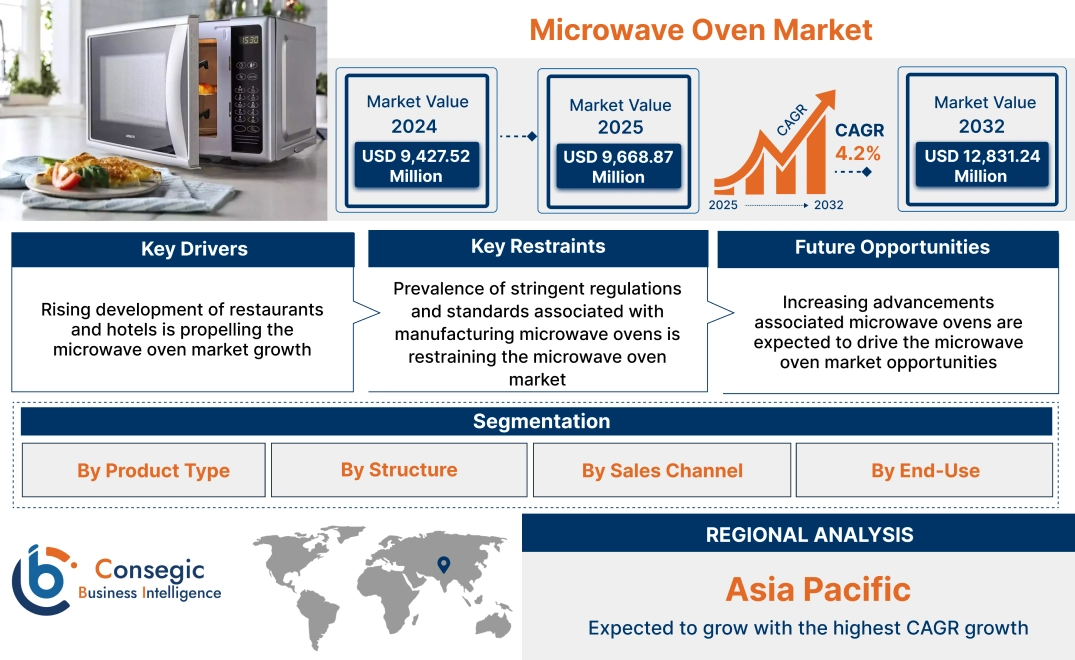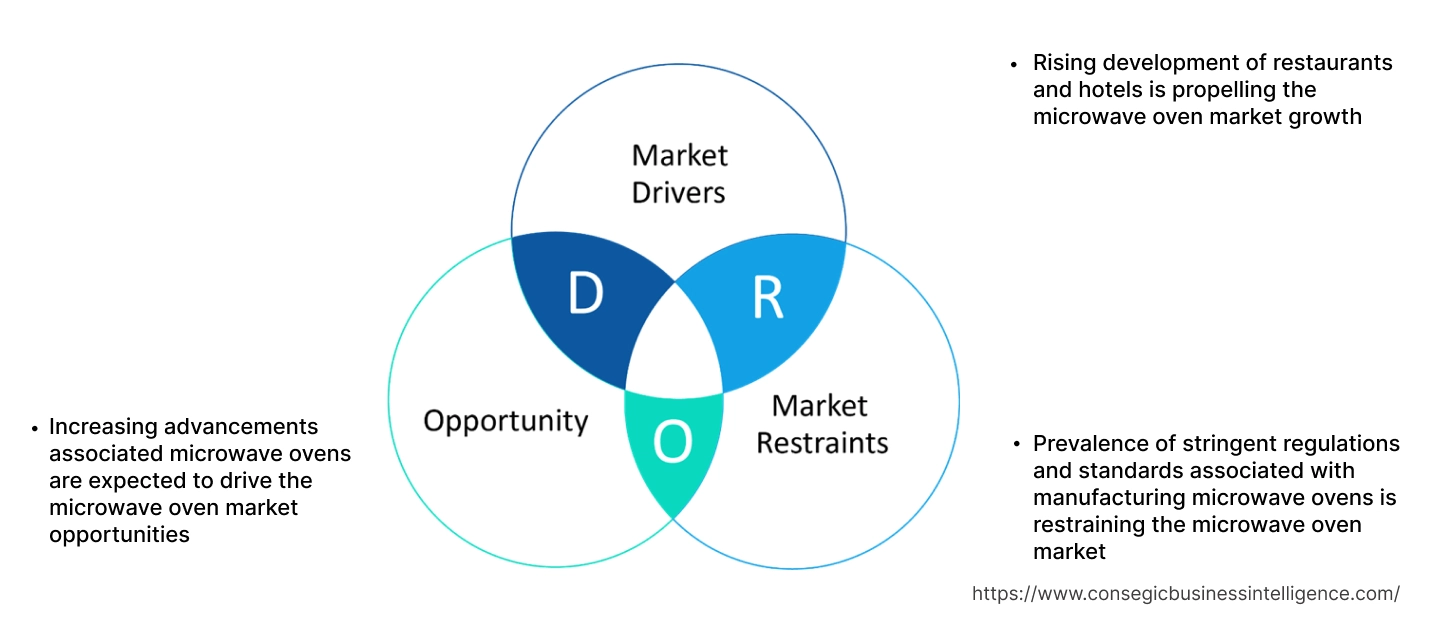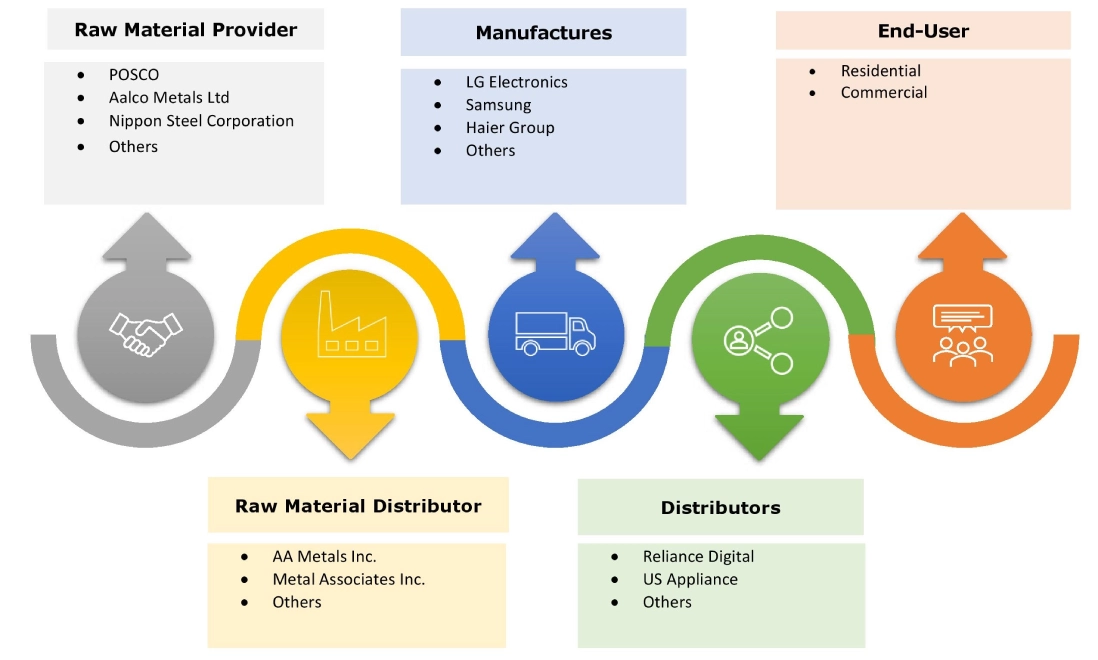- Summary
- Table Of Content
- Methodology
Microwave Oven Market Size:
Microwave Oven Market size is estimated to reach over USD 12,831.24 Million by 2032 from a value of USD 9,427.52 Million in 2024 and is projected to grow by USD 9,668.87 Million in 2025, growing at a CAGR of 4.2% from 2025 to 2032.
Microwave Oven Market Scope & Overview:
Microwave oven refers to an electric appliance that is designed for heating and cooking food by exposing it to electromagnetic radiation within the microwave frequency range. Moreover, the utilization of microwaves for heating and cooking food provides a range of benefits such as increased convenience, quick cooking, enhanced energy efficiency, ease of use and maintenance, versatile functions, and others. The aforementioned benefits of microwaves are key determinants for increasing its utilization in residential and commercial sectors.
Key Drivers:
Rising development of restaurants and hotels is propelling the microwave oven market growth
Microwaves are primarily used in food service sector including restaurants and hotels for applications including cooking and heating of several food items. Microwaves can considerably reduce the cooking time required for several food items, which is specifically useful in busy restaurant kitchens. Moreover, restaurants and hotels often prepare large quantities of food in advance. Microwaves are often used for quick reheating of food to ensure that meals are served hot. Additionally, the use of microwaves in restaurants and hotels offer improved operational efficiency, faster speed, and increased convenience, which makes it ideal for food service operation.
- For instance, in January 2023, Hyatt Hotels launched its new hotel SCHLOSS Roxburghe, which is a part of the Destination by Hyatt brand in the United Kingdom. The new hotel consists of 78 rooms, 12 luxury cottages and offers a range of amenities.
- Additionally, in November 2023, Salt Cafe launched its new restaurant outlet in Noida, India. The restaurant offers a variety of flavors along with Indian cuisine in its offerings.
Therefore, the rising development of restaurants and hotels is increasing the adoption of microwaves to ensure faster and convenient cooking and heating of several food items, in turn proliferating the microwave oven market size.
Key Restraints:
Prevalence of stringent regulations and standards associated with manufacturing microwave ovens is restraining the microwave oven market
The manufacturers of microwaves have to comply with numerous stringent standards such as ISO (International Organization for Standardization) standard, International Electrotechnical Commission: IEC 60335-2-25:2024 standard, CE (Conformite Européenne), and others.
ISO standard is among the primary standards that include ISO 9001 and ISO 14001, which apply to quality management and environmental management respectively. ISO standards provides a set of guidelines for microwave manufacturers to establish levels of homogeneity in accordance with the management, provision of services, and product development in the industry. Additionally, IEC 60335-2-25:2024 standard primarily deals with the safety of microwave ovens for household and similar usage, while ensuring that their rated voltage do not exceed 250 V.
Further, CE certification ensures that the microwave manufacturer takes responsibility for the compliance of a product with all applicable European health, performance safety, and environmental requirements. Hence, the prevalence of the aforementioned regulations and standards associated with manufacturing microwaves are hindering the microwave oven market expansion.
Future Opportunities :
Increasing advancements associated microwave ovens are expected to drive the microwave oven market opportunities
Microwave manufacturers are frequently investing in the development of new technologies associated with microwaves to ensure its safe and effective utilization in residential and commercial applications. As a result, oven manufacturers are launching new products with updated feature, which in turn is providing lucrative aspects for market growth.
- For instance, in October 2022, LG Electronics introduced its new range of 2022 microwave ovens, which are integrated with smart features, sophisticated designs, and latest technology. The new range of microwaves feature a stylish design while providing a healthier way of cooking and retaining the authentic taste.
Hence, as per the analysis, the rising advancements associated with microwaves are projected to boost the microwave oven market opportunities during the forecast period.
Microwave Oven Market Segmental Analysis :
By Product Type:
Based on product type, the market is segmented into convection, grill, and solo.
Trends in the product type:
- Increasing adoption of solo microwaves due to its compact and space saving design, simple operation, and relatively lower cost among others.
- There is a rising trend towards utilization of convection microwaves, attributing to its ability to bake, roast, grill, and reheat food quickly and efficiently.
The convection segment accounted for a largest revenue share of 48.82% in the total microwave oven market share in 2024.
- A convection microwave combines the functions of a microwave and convection oven, which enables users to bake and roast foods in addition to heating them. A convection microwave includes fan-assisted heating to facilitate even cooking.
- Moreover, convection microwave offers several benefits including versatile cooking, quicker meal preparation, even cooking, multiple cooking options, and others.
- For instance, Samsung offers MC32B7382QC model of convection microwaves in its product offerings. The convection microwave offers numerous features including smart control of the oven settings through app, reduced cooking time, and others.
- According to the microwave oven market analysis, the rising advancements associated with convection microwaves are driving the market.
The solo segment is anticipated to register a significant CAGR growth during the forecast period.
- A solo microwave refers to the most basic type of microwave oven. Solo microwave utilizes microwave radiation for heating food. Solo microwaves are mostly used for quick reheating and defrosting of food items.
- Solo microwaves usually feature compact and lightweight design, which makes it ideal for use in kitchens with limited space.
- Moreover, solo microwaves provide a broad range of benefits including compact and space saving design, quicker heating and defrosting of food items, simple operation, and relatively lower cost among others.
- For instance, LG Electronics offers MS2043DB model of solo microwave in its product portfolio. The solo microwave features i-wave patented technology, which enables faster and healthier cooking by facilitating even circulation of microwaves inside the cavity.
- Thus, increasing advancements related to solo microwaves are anticipated to propel the market during the forecast period.
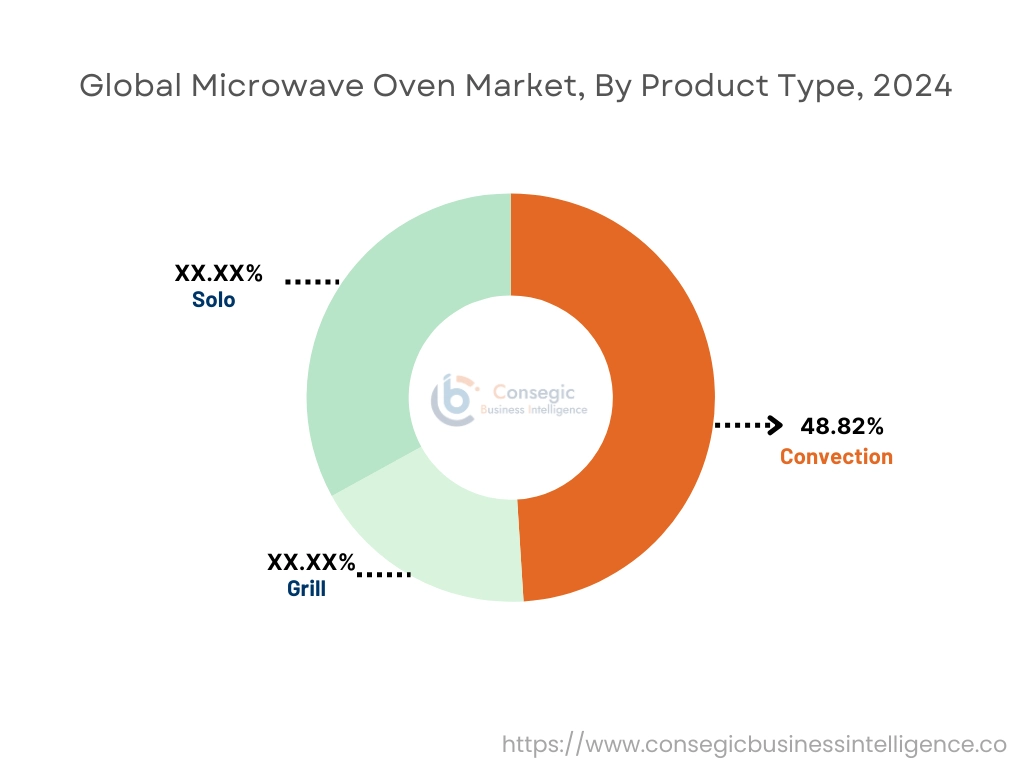
By Structure:
Based on structure, the market is segmented into built-in and countertop.
Trends in the Structure:
- Rising adoption of countertop microwaves due to its ease of installation, improved portability, and cost efficiency.
- Increasing installation of built-in microwaves, attributing to its countertop space saving design, sleek appearance, customizable height, and multi-functionalities.
The countertop segment accounted for the largest revenue in the overall market in 2024.
- Countertop microwaves refer to standalone units that are designed to sit on a kitchen counter or other flat surfaces.
- Countertop microwaves do not require any venting hook-ups or special installation, and they are portable and can be easily moved if required.
- Moreover, countertop microwaves offers a range of benefits including ease of installation, improved portability, ease of accessibility, and cost efficiency among others.
- For instance, GE Appliances offers a broad range of countertop microwaves in its product offerings. The countertop microwaves offer several features such as digital touch control, along with air fry, convection, and microwave with convection cooking technology.
- Therefore, increasing advancements associated with countertop microwaves are driving the microwave oven market growth.
The built-in segment is anticipated to register a significant CAGR growth during the forecast period.
- Built-in microwaves are designed to be integrated into kitchen cabinets or into fixed walls. Built-in microwaves can significantly save counter space by being integrated into kitchen cabinets, which is particularly beneficial for installation in smaller kitchens with limited space.
- Moreover, built-in microwaves provide numerous benefits including countertop space saving, sleek appearance, customizable height, and multi-functionalities among others.
- For instance, Robert Bosch offers series 6 and series 8 range of built-in ovens with microwaves in its product offerings. The built-in microwave features LED light for illumination of foods with minimum energy consumption, ease of cleaning, and others.
- Hence, the increasing development of built-in microwaves is anticipated to boost the microwave oven market size during the forecast period.
By Sales Channel:
Based on sales channel, the market is segmented into online and offline.
Trends in the sales channel:
- Factors including the availability of targeted advertising, ease of utilization, competitive pricing, along with reliable shipping and return policies are key prospects driving the online sales channel segment.
- Factors such as higher credibility, strong customer base, and ease of customization as per the target market are major determinants for driving the offline sales channel segment.
Online sales channel segment accounted for a significant revenue in the overall microwave oven market share in 2024.
- Online sales channel deploys a mode of distribution in which the manufacturers sell the products through the company websites or any other third-party e-commerce websites that are available on the internet.
- Online sales channels offer various benefits including a quicker buying process, easy access to the products, and higher flexibility.
- Moreover, the availability of microwaves in online sales channels allows quicker comparison of multiple products and prices and reduces overhead as compared to offline sales channels.
- For instance, Samsung and LG Electronics are few of the microwave manufacturers that offers a broad range of microwaves convection, grill, and solo microwaves for direct online purchase through the company’s website.
- Therefore, increasing availability of microwaves in online sales channels are driving the microwave oven market trends.
Offline sales segment is anticipated to register a substantial CAGR growth during the forecast period.
- Offline sales channel involves the distribution of microwaves from manufacturers to the end-users directly or indirectly through offline distributors including hypermarkets/supermarkets, specialty stores, and others.
- Moreover, offline sales channels play a significant role in enhancing the product supply and fulfilling customer demands in the local markets, which is a prime factor in increasing its utilization for the distribution of microwaves.
- For instance, Reliance Digital, an Indian retail chain of consumer electronics and goods, offers a wide range of microwaves for offline purchase through its several retail outlets that are prevalent in multiple cities across India.
- Therefore, the rising availability of microwaves in offline sales channel is projected to boost the market during the forecast period.
By End-Use:
Based on the end-use, the market is segmented into residential and commercial.
Trends in the end-use:
- Factors including the favorable government initiatives for development of smart homes and rising adoption of advanced household appliances for increased convenience are key trends driving the residential segment.
- The commercial sector has witnessed a significant increase in utilization of microwaves, particularly in hospitality and food service sectors such as restaurants, cafes, and hotels among others.
Residential segment accounted for a significant revenue share in the total market share in 2024.
- Microwaves are primarily used in residential households for cooking, reheating, and defrosting food items.
- Moreover, factor such as increased consumer demand for convenient and fast cooking solutions is driving the adoption of microwaves in residential spaces.
- Additionally, rising pace of urbanization and prevalence of compact living spaces are among the key factors driving the adoption of microwaves in residential spaces.
- For instance, according to the United States Census Bureau, the total number of new residential units sold in the United States reached up to 184 thousand units during the second quarter of 2023, witnessing an increase of 14.2% in comparison to 161 thousand units in second quarter of 2022.
- According to the analysis, the rising sales of residential units is driving the adoption of microwaves in residential kitchens, in turn propelling the market.
Commercial segment is anticipated to register a substantial CAGR during the forecast period.
- Microwaves are often used in commercial sector including restaurants, hotels, and others for applications including cooking and heating of several food items.
- Microwaves can considerably reduce the cooking time required for several food items, which is specifically useful in busy restaurant kitchens.
- Moreover, restaurants and hotels often prepare large quantities of food in advance. Microwaves are often used for quick reheating of food to ensure that meals are served hot.
- For instance, in February 2023, IHG Hotels & Resorts strengthens its presence in the United Kingdom with the addition of nine new hotels across the country.
- Hence, the increasing development of commercial spaces such as hotels, restaurants, and others is expected to boost the market during the forecast period.
Regional Analysis:
The regions covered are North America, Europe, Asia Pacific, the Middle East and Africa, and Latin America.
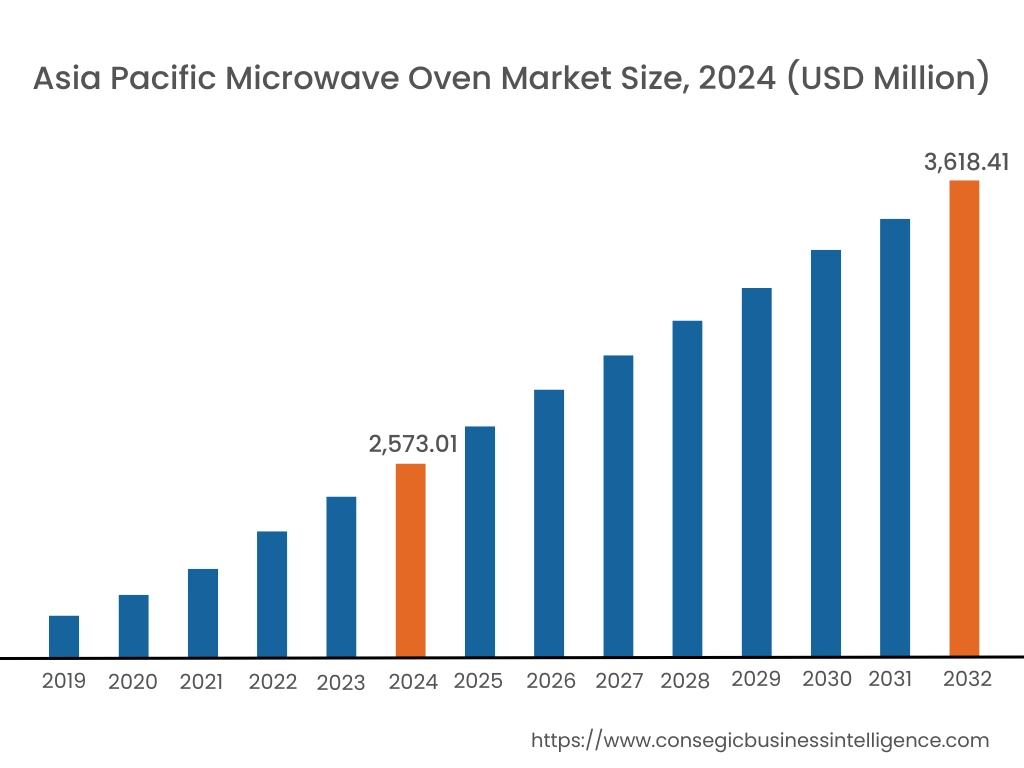
Asia Pacific region was valued at USD 2,573.01 Million in 2024. Moreover, it is projected to grow by USD 2,646.19 Million in 2025 and reach over USD 3,618.41 Million by 2032. Out of this, China accounted for the maximum revenue share of 32.5%. As per the microwave oven market analysis, the adoption of microwaves in the Asia-Pacific region is primarily driven by rising development of commercial and residential spaces among others. Additionally, the rising adoption of microwaves in residential and commercial spaces due to its increased convenience and improved energy efficiency is further accelerating the microwave oven market expansion.
- For instance, according to the Building and Construction Authority of Singapore, the total construction demand including residential and commercial construction in Singapore is reached between USD 24 billion to USD 29 billion by the end of 2024. The above factors are further driving the adoption of microwaves in residential and commercial spaces, in turn propelling the market in the Asia-Pacific region.
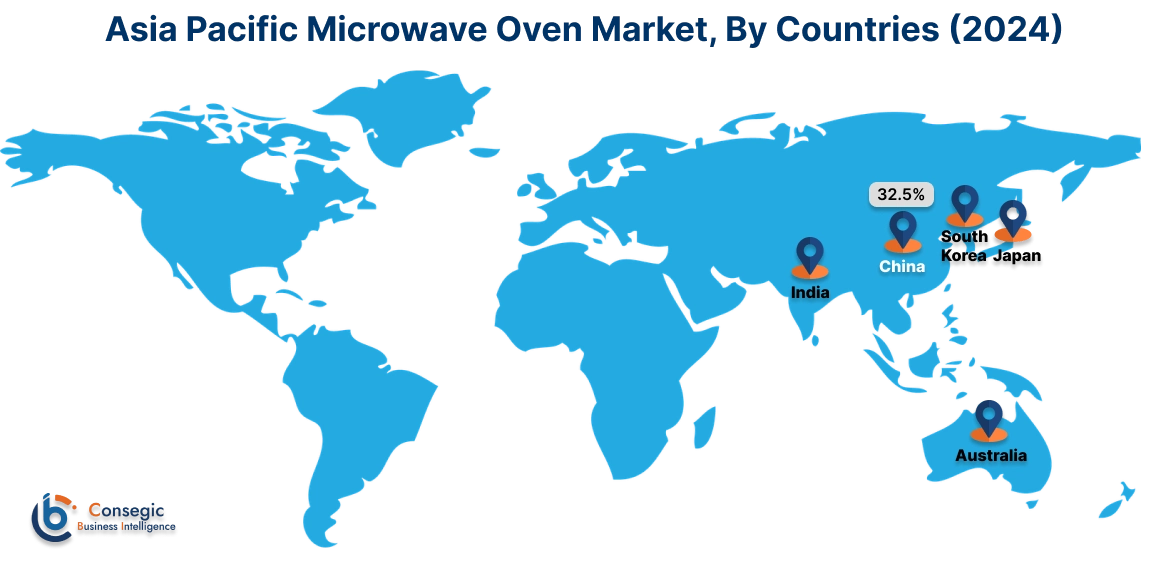
North America is estimated to reach over USD 4,421.65 Million by 2032 from a value of USD 3,255.06 Million in 2024 and is projected to grow by USD 3,337.85 Million in 2025. In North America, the growth of microwave oven industry is driven by rising investments in residential and commercial construction projects along with increasing installation of advanced kitchen appliances among others. Similarly, the rising demand for energy-efficient, convenient, and faster cooking solutions are further contributing to the microwave oven market demand.
- For instance, according to the United States Census Bureau, the total number of new residential units sold in the United States reached up to 666 thousand units in 2023, witnessing a growth of nearly 4% in comparison to 641 thousand units in 2022. The above factors are projected to drive the microwave oven market trends in North America during the forecast period.
The regional analysis depicts that rising adoption of microwaves in hospitality and food service sectors such as restaurants, hotels, and others are driving the microwave oven market demand in Europe. Furthermore, as per the market analysis, the market demand in Latin America, Middle East, and African regions is expected to grow at a considerable rate due to factors such as rising pace of urbanization and increasing investments in development of residential and commercial spaces among others.
Top Key Players and Market Share Insights:
The global microwave oven market is highly competitive with major players providing products to the national and international markets. Key players are adopting several strategies in research and development (R&D), product innovation, and end-user launches to hold a strong position in the microwave oven market. Key players in the microwave oven industry include-
- LG Electronics (South Korea)
- Samsung (South Korea)
- GE Appliances (U.S)
- Breville Ltd (Australia)
- Electrolux AB (Sweden)
- Robert Bosch GmbH (Germany)
- Haier Group (China)
- Whirlpool Corporation (U.S)
- Panasonic Corporation (Japan)
- Sharp Corporation (Japan)
Recent Industry Developments :
Product Launch:
- In October 2022, LG Electronics introduced its new range of 2022 microwaves. The microwaves are integrated with smart features, sophisticated designs, and latest technology.
Partnerships & Collaborations:
- In August 2023, LG Electronics partnered with ITC Foods, an India-based packaged food business, with the aim of redefining the cooking experience for consumers in the country. As part of this partnership, the company has announced 2 new microwaves integrated with scan to cook feature.
Microwave Oven Market Report Insights :
| Report Attributes | Report Details |
| Study Timeline | 2019-2032 |
| Market Size in 2032 | USD 12,831.24 Million |
| CAGR (2025-2032) | 4.2% |
| By Product Type |
|
| By Structure |
|
| By Sales Channel |
|
| By End Use |
|
| By Region |
|
| Key Players |
|
| North America | U.S. Canada Mexico |
| Europe | U.K. Germany France Spain Italy Russia Benelux Rest of Europe |
| APAC | China South Korea Japan India Australia ASEAN Rest of Asia-Pacific |
| Middle East and Africa | GCC Turkey South Africa Rest of MEA |
| LATAM | Brazil Argentina Chile Rest of LATAM |
| Report Coverage |
|
Key Questions Answered in the Report
How big is the microwave oven market? +
The microwave oven market was valued at USD 9,427.52 Million in 2024 and is projected to grow to USD 12,831.24 Million by 2032.
Which is the fastest-growing region in the microwave oven market? +
Asia-Pacific is the region experiencing the most rapid growth in the microwave oven market.
What specific segmentation details are covered in the microwave ovens report? +
The microwave ovens report includes specific segmentation details for product type, structure, sales channel, end-use, and region.
Who are the major players in the microwave oven market? +
The key participants in the microwave oven market are LG Electronics (South Korea), Samsung (South Korea), Robert Bosch GmbH (Germany), Haier Group (China), Whirlpool Corporation (U.S), Panasonic Corporation (Japan), Sharp Corporation (Japan), GE Appliances (U.S), Breville Ltd (Australia), and Electrolux AB (Sweden).
